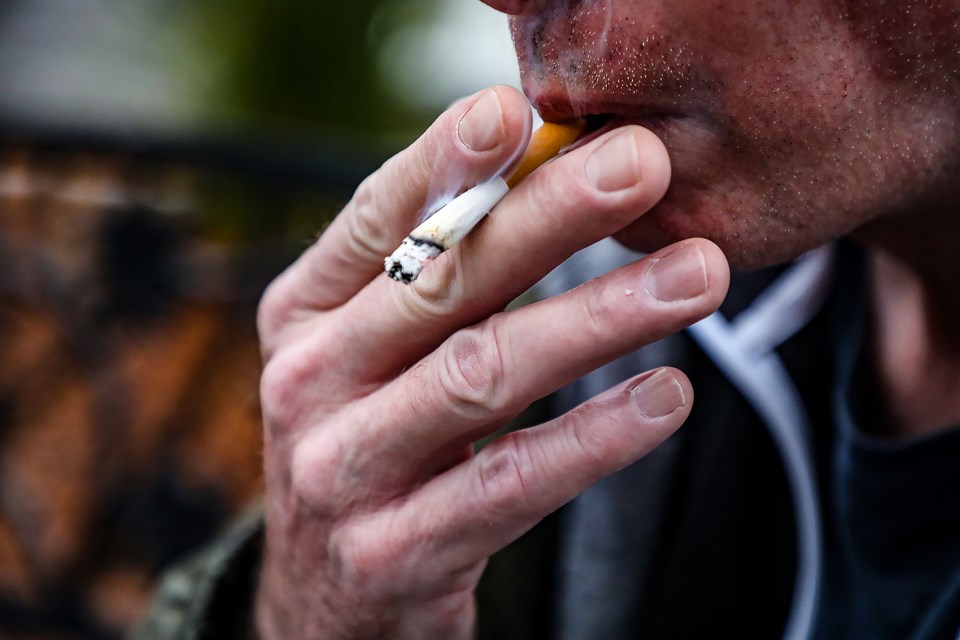BANFF – Smoking and vaping tobacco or nicotine will be banned in most public places in Banff.
On Monday (Dec. 12), council passed a municipal bylaw that goes beyond provincial legislation and bans tobacco smoking and vaping in municipal parks, green spaces, trails, pathways, outdoor markets, events, bus stops, public sidewalks, pedestrian zones, and in proximity to children.
Fines for contravening the new bylaw, which comes into effect on Feb. 1, 2023, range from $250 to $500.
“A lot of people in this room probably remember when you could smoke on an airplane, when you could smoke in a restaurant, and when you could smoke just about anywhere, and those days, thankfully, are long gone,” said Coun. Grant Canning.
“This is just an extension of the view of society, the view of public health about how to deal with this issue."
Other than an exemption for the ceremonial use of tobacco performed in traditional Indigenous practices, smoking or vaping of tobacco in Banff will be predominantly limited to parking lots, alleys and private property.
In the remaining public areas where smoking is permitted, however, it must not occur within five metres from sidewalks or trails, as per the municipal bylaw, or within five metres from open doorways or windows as stated within provincial legislation.
Administrative officials say the bylaw is based on the so-called gold standard endorsed by the Action on Smoking and Health (ASH) – a leading tobacco control lobbying organization – which has been adopted by other municipalities such as Okotoks and Strathmore.
Alison Gerrits, the director of community services for the Town of Banff, said additional public smoking restrictions have been discussed at the council table dating back to June of 2018 when the topic first emerged during cannabis legalization.
She said this topic has been discussed at least seven times by council or the governance and finance committee since 2018, noting community feedback has been sought.
“The aim is to add additional smoke-free areas in public places throughout the community that goes beyond current provincial legislation,” she said.
Les Hagen, executive director of ASH, said Banff’s bylaw will effectively align restrictions with smoking and vaping of tobacco and nicotine with those on cannabis by placing equivalent public restrictions on the use of both legal products.
“Tobacco use kills about 50 times more Canadians than cannabis and, therefore, any restrictions that can be placed on cannabis certainly can be justified for tobacco,” he said.
Hagen said social modelling of smoking and vaping can have a profound impact on children and youth.
“To a five-year-old, smoking is smoking whether it involves tobacco, cannabis, shisha, pipes, cigars, joints or cigarettes. The more smoking cues a child receives, the more likely they are to become smokers themselves,” he said.
“Psychological science has revealed that social modelling can be just as influential as parental modelling and it truly does take a village to raise a child.”
According to ASH, more than 400,000 Canadian youth in grades 7 to 12, which translates to about 50,000 Alberta youth, have used nicotine vaping products when last measured.
“We are currently dealing with an epidemic of youth vaping in Canada,” Hagen said. “Kids who vape are at least three times as likely to start smoking.”
While recognizing Banff council’s jurisdiction is confined to the townsite boundaries, Hagen said ASH believes all municipal, provincial and national parks should be smoke-free.
He said ASH is launching a national campaign next month to urge the federal government to make all national parks smoke-free in support of the federal tobacco reduction strategy.
“The proposed smoking bylaw provides a great springboard for a campaign to make our parks smoke-free,” Hagen said.
Hagen also said careless smoking is responsible for 10 to 15 per cent of all wildfires in Canada, pointing to the infamous 2017 wildfire at Elephant Hill that burned almost 200,000 hectares and destroyed more than 100 homes in B.C.’s south-central interior.
The BC Wildfire Service concluded the most likely cause of the Elephant Hill wildfire was smoking or smoking materials, which classification includes matches, cigars, pipe tobacco, cigarettes and marijuana.
“We don’t need a similar fire in Banff,” Hagen said
Coun. Hugh Pettigrew was the lone councillor to vote against the bylaw amid concerns about enforcement.
While also worried about how to enforce the bylaw, Coun. Ted Christensen supported the move.
“Usually I am reluctant to support a bylaw that is difficult to enforce, but in this case, I think the strength of the message is important,” he said.
Mayor Corrie DiManno said the bylaw sets a social standard.
“It’s also about setting the tone that when you are in Banff we are a community and we value our clean mountain air, and we’re respectful of public places and our environment, “ she said.
“It’s also about improving the health of our community and about modelling behaviour for the youth who we know can be influenced strongly by the behaviour of adults."
DiManno said she believes the bylaw will also lead to fewer discarded cigarette butts, thereby reducing the risk of starting a wildfire.
“If you don’t believe me, I would encourage anyone to go walk around the river and clean up cigarette butts,” she said. “There are thousands of cigarette butts out there in our townsite.”
The Town of Banff will launch an education campaign on the new bylaw before it comes into effect in February.




